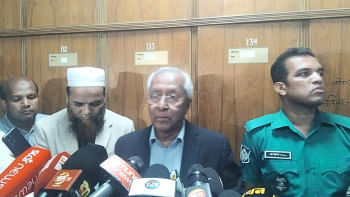Dhaka’s wetlands and Nature-based Solutions for sustainable future

Nature-based Solutions (NbS) is a term that is increasingly gaining prominence in global climate adaptation discourse. NbS unify existing ecosystem-based strategies emphasising the use of natural processes to manage environmental risks. By protecting, restoring, and integrating natural ecosystems into the fabric of the city, NbS promises not only climate resilience but also social, economic and other environmental co-benefits. However, the critical question for Dhaka (and for many rapidly urbanising cities in the Global South) is whether our planning laws and urban governance frameworks meaningfully support the implementation of NbS?
Dhaka's geography places it at the confluence of multiple flood risks including monsoon rainfall, riverine floods, and drainage congestion. Its urban wetlands, which once acted as buffers absorbing excess rainwater and mitigating floods, have declined by more than 75% since the 1960s. These wetlands are not just passive spaces but living infrastructure. They store stormwater, replenish groundwater, cool microclimates, and provide habitats for biodiversity all critical services in a warming, water-stressed future. Land use continues to degrade and, in some cases, remove wetlands that fulfil a necessary planetary function of absorbing water thereby helping to reduce the major impacts of flooding. The biodiversity and ecosystems of wetlands have tremendous ecological value that is instrumental to sustainable development and livelihoods. Yet, in Dhaka, NbS remains more as a trendy policy term than as a guiding urban planning principle.
Looking from afar, a cultural change is required at the local level that acknowledges the economic benefits associated with ecosystem services and Nature-based Solutions, rather than the sustained, continual deference to the immediate economic returns associated with private property interests and zoning land for purely commercial and residential purposes.
Notably, Bangladesh has taken significant steps toward integrating ecosystem values into its national development planning, including Five Year Plans (FYP), the National Adaptation Plan to Combat Climate Adaptation (NAP), the Perspective Plan 2041 (PP2041) and the Bangladesh Delta Plan 2100 (BDP). These policies consider concepts related to NbS to varying degrees, albeit at a high level. The 8th FYP, for example, includes NbS through a solitary reference, indicating that the National Adaptation Plan (NAP) will give priorities in Nature Based Solutions (NBS) and Ecosystem Based Adaptation (EbA). However, the 8th FYP leaves NbS undefined and without any guidance in terms of implementation. Similarly, NAP operates to 'facilitate the integration of climate change adaptation, into relevant new and existing policies, programmes and activities in a coherent manner, in particular development planning processes and strategies.'
On the other hand, the 8th FYP, connected to the PP2041, includes six core themes, including: 'a sustainable development pathway resilient to disaster and climate change.' This is expanded to include a sustainable climate migration and the need for responsible protection of wetlands in Dhaka that is resilient to disaster and climate change. It also entails sustainable use of natural resources and management of inevitable urbanisation transition. The PP2041 reiterates the need for balance under the vision for achieving safe, climate resilient and prosperous delta. However, there is also a sobering admission that the overall implementation of existing environmental laws and regulations remains a difficult challenge.
The BDP provides the strongest linkage between climate change adaptation, biodiversity, and planning by promoting nature-based management strategies rather than prioritising short term, infrastructure-based solutions. Examples of these practices include the provision for greater flood resilient habitats, natural reservoir restoration and conservation. The BDP also separately mentions the need to manage flood risk and the conservation of ecosystems separately in Goals 1 and 4. Flooding and subsequent waterlogging are identified as two of the most prominent water related challenges for development. However, the situation is worsened by unplanned urbanisation in illegally encroached floodplains, ineffective drainage infrastructure, encroachment on wetlands in urban and rural areas.
The BDP similarly emphasises strategies such as increasing drainage capacity, reducing flood risk and water logging in urban areas and conserving urban wetlands to strengthen adaptive capacity. Land use planning is integral part of BDP, with the Urban Areas Hotspot highlighting that uncontrolled growth and haphazard development are closely linked to water-related issues. The BDP recognises the relevance of planning law to achieve this strategy, with the BDP calling for the formulation of a Spatial Planning and Land Resource Management Act.
Analysing the FYP, NAP, PP2041 and the BDP against Smith and others' four enabling mechanisms for greater NbS implementation, it is evident that Bangladeshi development policy does indicate a greater awareness of ecosystem-orientated interventions, including NbS. However, a synthesis of NbS practices has identified that the lack of guidance documentation, including information on how to measure effectiveness that can be utilised by law and policy makers. To date, the Bangladesh Planning Commission has led a consultation on how to include NbS into development planning, which recommended greater incorporation of NbS into the FYPs, Bangladesh's Nationally Determined Contributions (NDCs) under the UNFCCC framework, and greater consideration of NbS in government project design guidelines. However, the realisation of greater NbS consideration as development projects requires greater local community participation and engagement that can impart local knowledge and effectively translate the high level NbS concepts into practical guidance. As such, there continues to be a disconnect between high level policy ideas and implementation of NbS at localised levels and contexts.
However, there is no need to start from the scratch. The Hatirjheel project offers valuable lessons for future NbS implementation in Bangladesh. The design of the area demonstrates a policy shift by allowing ecosystem functions to occur and creating urban spaces that coexist with wetlands. However, limited consultation with residents, planners, and waste officials resulted in the inability to identify the lack of waste treatment as potential risks, leading to pollution. Moreover, opaque governance and political influence of illegal occupants enabled encroachment, undermining the original 'blue network' vision.
Whilst the decision from the High Court has reinforced the land tenure held by the DNCC, the real test is whether local planning authorities and regulators can enforce this ruling from the High Court given the lack of administrative capacity and the political environment and influence that illegal occupants hold over local administrative bodies. Looking from afar, a cultural change is required at the local level that acknowledges the economic benefits associated with ecosystem services and NbS, rather than the sustained, continual deference to the immediate economic returns associated with private property interests and zoning land for purely commercial and residential purposes.
The authors serve as faculty members at Macquarie Law School, Macquarie University.

 For all latest news, follow The Daily Star's Google News channel.
For all latest news, follow The Daily Star's Google News channel. 



Comments